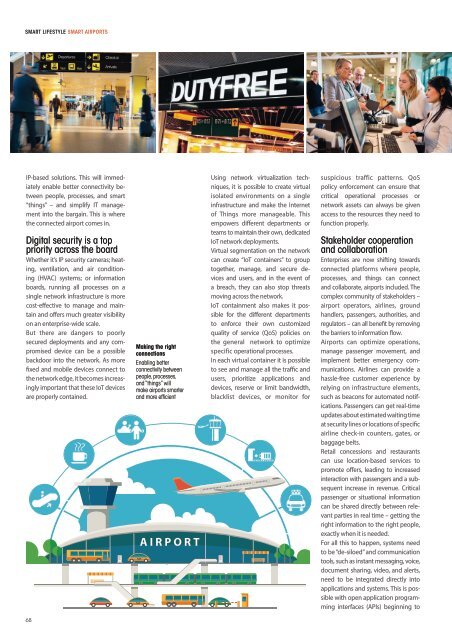Smart Industry 1/2018
Smart Industry 1/2018 - The IoT Business Magazine - powered by Avnet Silica
Smart Industry 1/2018 - The IoT Business Magazine - powered by Avnet Silica
Create successful ePaper yourself
Turn your PDF publications into a flip-book with our unique Google optimized e-Paper software.
<strong>Smart</strong> Lifestyle <strong>Smart</strong> Airports<br />
IP-based solutions. This will immediately<br />
enable better connectivity between<br />
people, processes, and smart<br />
“things” – and simplify IT management<br />
into the bargain. This is where<br />
the connected airport comes in.<br />
Digital security is a top<br />
priority across the board<br />
Whether it’s IP security cameras; heating,<br />
ventilation, and air conditioning<br />
(HVAC) systems; or information<br />
boards, running all processes on a<br />
single network infrastructure is more<br />
cost-effective to manage and maintain<br />
and offers much greater visibility<br />
on an enterprise-wide scale.<br />
But there are dangers to poorly<br />
secured deployments and any compromised<br />
device can be a possible<br />
backdoor into the network. As more<br />
fixed and mobile devices connect to<br />
the network edge, it becomes increasingly<br />
important that these IoT devices<br />
are properly contained.<br />
Making the right<br />
connections<br />
Enabling better<br />
connectivity between<br />
people, processes,<br />
and “things” will<br />
make airports smarter<br />
and more efficient<br />
Using network virtualization techniques,<br />
it is possible to create virtual<br />
isolated environments on a single<br />
infrastructure and make the Internet<br />
of Things more manageable. This<br />
empowers different departments or<br />
teams to maintain their own, dedicated<br />
IoT network deployments.<br />
Virtual segmentation on the network<br />
can create “IoT containers” to group<br />
together, manage, and secure devices<br />
and users, and in the event of<br />
a breach, they can also stop threats<br />
moving across the network.<br />
IoT containment also makes it possible<br />
for the different departments<br />
to enforce their own customized<br />
quality of service (QoS) policies on<br />
the general network to optimize<br />
specific operational processes.<br />
In each virtual container it is possible<br />
to see and manage all the traffic and<br />
users, prioritize applications and<br />
devices, reserve or limit bandwidth,<br />
blacklist devices, or monitor for<br />
suspicious traffic patterns. QoS<br />
policy enforcement can ensure that<br />
critical operational processes or<br />
network assets can always be given<br />
access to the resources they need to<br />
function properly.<br />
Stakeholder cooperation<br />
and collaboration<br />
Enterprises are now shifting towards<br />
connected platforms where people,<br />
processes, and things can connect<br />
and collaborate, airports included. The<br />
complex community of stakeholders –<br />
airport operators, airlines, ground<br />
handlers, passengers, authorities, and<br />
regulators – can all benefit by removing<br />
the barriers to information flow.<br />
Airports can optimize operations,<br />
manage passenger movement, and<br />
implement better emergency communications.<br />
Airlines can provide a<br />
hassle-free customer experience by<br />
relying on infrastructure elements,<br />
such as beacons for automated notifications.<br />
Passengers can get real-time<br />
updates about estimated waiting time<br />
at security lines or locations of specific<br />
air line check-in counters, gates, or<br />
baggage belts.<br />
Retail concessions and restaurants<br />
can use location-based services to<br />
promote offers, leading to increased<br />
inter action with passengers and a subsequent<br />
increase in revenue. Critical<br />
passenger or situational information<br />
can be shared directly between relevant<br />
parties in real time – getting the<br />
right information to the right people,<br />
exactly when it is needed.<br />
For all this to happen, systems need<br />
to be “de-siloed” and communication<br />
tools, such as instant messaging, voice,<br />
document sharing, video, and alerts,<br />
need to be integrated directly into<br />
applications and systems. This is possible<br />
with open application programming<br />
interfaces (APIs) beginning to<br />
68
















